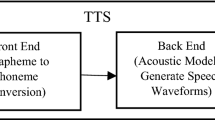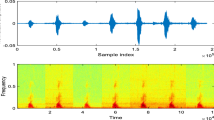Abstract
Language Identification has gained significant importance in recent years, both in research and commercial market place, demanding an improvement in the ability of machines to distinguish between languages. Although methods like Gaussian mixture models, hidden Markov models and neural networks are used for identifying languages the problem of language identification in noisy environments could not be addressed so far. This paper addresses the performance of automatic language identification system in noisy environments. A comparative performance analysis of speech enhancement techniques like minimum mean squared estimation, spectral subtraction and temporal processing, with different types of noise at different SNRs, is presented here. Though these individual enhancement techniques may not yield good performance with different types of noise at different SNRs, it is proposed to combine the evidences of all these techniques to improve the overall performance of the system significantly. The language identification studies are performed using IITKGP-MLILSC (IIT Kharagpur-Multilingual Indian Language Speech Corpus) databases which consists of 27 languages.

Similar content being viewed by others
References
Ambikairajah, E., et al. (2011). Language identification: A tutorial. Circuits and Systems Magazine IEEE, 11(2), 82–108.
Benesty, J., Sondhi, M. M., & Huang, Y. (Eds.). (2008). Springer handbook of speech processing. Berlin: Springer.
Boll, S. (1979). Suppression of acoustic noise in speech using spectral subtraction. IEEE Transactions on Acoustics, Speech and Signal Processing, 27(2), 113–120.
Dempster, A. P., Laird, N. M., & Rubin, D. B. (1977). Maximum likelihood from incomplete data via the EM algorithm. Journal of the Royal Statistical Society. Series B (Methodological), 39, 1–38.
Ephraim, Y., & Malah, D. (1985). Speech enhancement using a minimum mean-square error log-spectral amplitude estimator. IEEE Transactions on Acoustics, Speech and Signal Processing, 33(2), 443–445.
Foil, J. (1986). Language identification using noisy speech. Acoustics, Speech, and Signal Processing, IEEE international conference on ICASSP’86. Vol. 11. IEEE.
Goodman, F. J., Martin, A. F., & Wohlford, R. (1989). Improved automatic language identification in noisy speech. Acoustics, Speech, and Signal Processing, 1989. ICASSP-89., 1989 international conference on. IEEE.
Hegde, R. M., & Murthy, H. A. (2005) Automatic language identification and discrimination using the modified group delay feature. In Intelligent Sensing and Information Processing, 2005. Proceedings of 2005 International Conference on. IEEE.
Jothilakshmi, S., Ramalingam, V., & Palanivel, S. (2012). A hierarchical language identification system for Indian languages. Digital Signal Processing, 22(3), 544–553.
Krishnamoorthy, P., & Prasanna, S. R. M. (2009). Application of combined temporal and spectral processing methods for speaker recognition under noisy, reverberant or multi-speaker environments. Sadhana, 34(5), 729–754.
Lander, T., Cole, R., Oshika, B., & Noel, M. (1995). The OGI 22 language telephone speech corpus. In Eurospeech (pp. 1894–1903).
Lawson, A., McLaren, M., Lei, Y., Mitra, V., Scheffer, N., Ferrer, L., & Graciarena, M. (2013). Improving language identification robustness to highly channel-degraded speech through multiple system fusion. In INTERSPEECH (pp. 1507–1510). Lyon.
Maity, S., et al. (2012). IITKGP-MLILSC speech database for language identification. Communications (NCC), 2012 National Conference on. IEEE.
Mary, L., & Yegnanarayana, B. (2008). Extraction and representation of prosodic features for language and speaker recognition. Speech Communication, 50(10), 782–796.
Nakagawa, S., Ueda, Y., & Seino T. (1992). Speaker-independent, text-independent language identification by HMM. ICSLP. Vol. 92.
Rao, K. S., Maity, S., & Reddy, V. R. (2013). Pitch synchronous and glottal closure based speech analysis for language recognition. International Journal of Speech Technology, 16(4), 413–430.
Reddy, V. R., Maity, S., & Rao, K. S. (2013). Identification of Indian languages using multi-level spectral and prosodic features. International Journal of Speech Technology, 16(4), 489–511.
Reynolds, D. A., & Rose, R. C. (1995). Robust text-independent speaker identification using Gaussian mixture speaker models. IEEE Transactions on Speech and Audio Processing, 3(1), 72–83.
Vuppala, A. K., Rao, K. S., Chakrabarti, S., Krishnamoorthy, P., & Prasanna, S. R. M. (2011). Recognition of consonant-vowel (CV) units under background noise using combined temporal and spectral preprocessing. International Journal of Speech Technology, 14(3), 259–272.
Vuppala, A. K., & Sreenivasa Rao, K. (2013). Vowel onset point detection for noisy speech using spectral energy at formant frequencies. International Journal of Speech Technology, 16(2), 229–235.
Zissman, M. A. (1996). Comparison of four approaches to automatic language identification of telephone speech. IEEE Transactions on Speech and Audio Processing, 4(1), 31.
Acknowledgments
The authors are grateful to Dr K Sreenivasa Rao, Associate Professor and his team at School of Information Technology (SIT), IIT Kharagpur for providing IIT Kharagpur-Multilingual Indian Language Speech Corpus) databases which consists of 27 languages. We would also like to thank their suggestions and helpful discussions.
Author information
Authors and Affiliations
Corresponding author
Rights and permissions
About this article
Cite this article
Polasi, P.K., Sri Rama Krishna, K. Combining the evidences of temporal and spectral enhancement techniques for improving the performance of Indian language identification system in the presence of background noise. Int J Speech Technol 19, 75–85 (2016). https://doi.org/10.1007/s10772-015-9326-0
Received:
Accepted:
Published:
Issue Date:
DOI: https://doi.org/10.1007/s10772-015-9326-0




